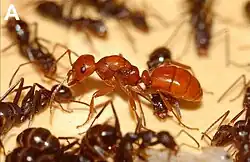| Formica archboldi | |
|---|---|
 | |
| F. archboldi are the darker-colored ants in this image, the reddish-orange one in the center is a Polyergus lucidus queen | |
| Scientific classification | |
| Domain: | Eukaryota |
| Kingdom: | Animalia |
| Phylum: | Arthropoda |
| Class: | Insecta |
| Order: | Hymenoptera |
| Family: | Formicidae |
| Subfamily: | Formicinae |
| Tribe: | Formicini |
| Genus: | Formica |
| Species: | F. archboldi |
| Binomial name | |
| Formica archboldi Smith, 1944 | |
Formica archboldi is a species of ant in the family Formicidae.[1][2][3][4][5][6][7] They are known for their abnormal behavior, which includes the collection and storage of Odontomachus (trap-jaw) ant skulls.
Formica archboldi ants store these severed ant heads in their nests. The Formica archboldi have odors that are chemically similar to the odors of the trap-jaw ants, which might allow the Formica ants to disguise themselves among the trap-jaw ants. The Formica ants immobilize the trap-jaw ants by spraying formic acid, dragging them into the nest, and dismembering them.[8][9]
Further reading
- Bolton, B. (3 May 2016). "Catalogue of the Ants of the World" (PDF). unpublished communication. Retrieved 2019-07-02.
References
- ↑ "Formica archboldi Report". Integrated Taxonomic Information System. Retrieved 2018-05-07.
- ↑ "Formica archboldi species details". Catalogue of Life. Retrieved 2018-05-07.
- ↑ "Formica archboldi". GBIF. Retrieved 2018-05-07.
- ↑ "Formica archboldi Species Information". BugGuide.net. Retrieved 2018-05-07.
- ↑ Ward, Philip S.; Blaimer, Bonnie B.; Fisher, Brian L. (2016). "A revised phylogenetic classification of the ant subfamily Formicinae(Hymenoptera: Formicidae), with resurrection of the genera Colobopsis and Dinomyrmex". Zootaxa. Magnolia Press. 4072 (3): 343–57. doi:10.11646/zootaxa.4072.3.4. PMID 27395929.
- ↑ Wilson, Christopher M.; Smith-Herron, Autumn (2016). "Morphology of the male genitalia of Brachymyrmex and their implications in the Formicinae phylogeny". Journal of Hymenoptera Research. Pensoft Publishers. 50: 81–95. doi:10.3897/JHR.50.8697. ISSN 1070-9428.
- ↑ "AntWeb". California Academy of Sciences. Retrieved 2018-05-07.
- ↑ "Skull-collecting ants slay with acid". Nature. 16 November 2018. Retrieved 2018-11-19.
- ↑ Smith, Adrian (16 November 2018). "Predatory behavior of Florida's skull-collecting ant". ScienceDaily. Retrieved 2018-11-19.
External links
 Media related to Formica archboldi at Wikimedia Commons
Media related to Formica archboldi at Wikimedia Commons
This article is issued from Wikipedia. The text is licensed under Creative Commons - Attribution - Sharealike. Additional terms may apply for the media files.